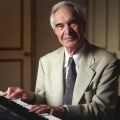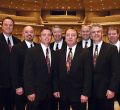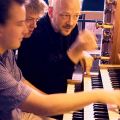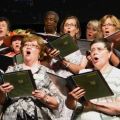Children's books: Space, bugs, saints, humor and more
WASHINGTON - The following children's books are suitable for Christmas giving:
In search of the wines from biblical times
TORONTO - In Divine Vintage: Following the Wine Trail from Genesis to Modern Times, authors Randall Heskett and Joel Butler ask not what would Jesus do but rather what wine would Jesus drink?
Catholic jazz pianist Dave Brubeck dies
WASHINIGTON - Dave Brubeck, the influential and prolific pianist whose composition "Take Five" became a standard in the annals of jazz, died Dec. 5 at age 91, one day before his 92nd birthday.
Choir school camaraderie continues with The Mistletones
TORONTO - After years of singing together on a daily basis at St. Michael’s Choir School in Toronto, a group of alumni came together to continue making music.
Called The Mistletones, their love of song and unique vocal blend have culminated in a sold-out Christmas concert on Dec. 13 at Toronto’s Glenn Gould Studio.
“The style of the group is a combination of choral and jazz,” said Gerry Litster, group member and choir school alumni, who is also joined in the group by his brother, Mike.
“We are definitely not barbershop as some have asked in the past, although for the most part our singing is a capella.”
The all-male voiced group, who sing in TTBB vocal formation, have been together since 1980 and have been friends since their days at the choir school — some even knowing one another for as many as 49 years.
“The group was formed to fill the musical void we experienced after graduation from the choir school,” said Douglas Tranquada.
The Mistletones currently consist of nine members: Pat Power and Rob Thomas (bass); Tranquada, Paul Townshend and Paul Kenny (baritone); the Litster brothers (second tenor); Dan Fantin and Leonard Tawaststjerna (first tenor).
Their rich blend and concise, complex harmonic aptitude form a unique and well-developed vocal style.
“We all had musical training during our years at the choir school,” said Townshend. “That included piano, organ, theory, harmony and music history.”
Their sold-out show will highlight the group’s dense vocal harmonics, all while showcasing favourite music of the Christmas season.
“The program is a mix of a few sacred songs along with some popular Christmas favourites, but not your typical Christmas carols,” says Tawaststsjerna.
The group has performed in some of the city’s most storied venues, places such as Roy Thomson Hall, Koerner Hall, the Princess of Wales Theatre and Massey Hall.
This time around, The Mistletones are looking forward to bringing their sound to an audiences at a venue that has a unique atmosphere.
“The beauty of GGS (Glenn Gould Studio) is that it’s like singing in an intimate surrounding — not unlike being in someone’s living room,” said Kenny.
For more information on The Mistletones visit their facebook page at www.facebook.com/therealmistletones.
David Braid, a faithful performer
TORONTO - Pianist David Braid originally got into jazz after developing a deep affinity for one of history’s greatest composers — Mozart. Indeed, it was once said of Braid, by the Halifax Chronicle-Herald, “If Mozart played jazz, he’d be David Braid.”
Currently en route to Beijing to perform two concerts, Braid’s resumé boasts two Juno Award wins, Jazz Pianist of the Year in Canada and a SOCAN Composer of the Year award. He has composed more than 80 works for piano, ensembles and orchestras, and has released nine recordings. However, despite his lauded career and whirlwind of performance engagements, Braid cites a much more reflective inspiration for some of his work — one that comes from a Sunday evening student Mass at the St. Thomas Aquinas Chapel at the Newman Centre at the University of Toronto.
“The students seemed particularly still in a moment of silent prayer while a particularly beautiful but irregular hymn with an atypical harmonic movement and meter was being performed. The feeling of that particular harmony, rhythm and meter at that particular moment impressed upon me a buoyancy and uplifting feeling which I liked very much,” said Braid.
“I wanted to capture that and recreate that feeling in a piece of my own to share with my audiences. Fifteen years later, my composition ‘Say a Silent Prayer’ is one of my most performed and popular pieces.”
This inspiration, drawn deeply from a lifelong involvement in the Catholic Church, presents itself in Braid’s prolific body of work — not always in an obvious sense, but subtly colouring his uniquely melodic compositions.
“In a general way, when I think about the largest quantity of music I was exposed to throughout my childhood, it must have been church music at Sunday Mass because music was not a big part of my culture at home outside of my piano studies,” said Braid. “In my opinion, the large body of hymns in The Catholic Book of Worship, which I hear every Sunday, never manifest in any of my writing, but I think there is a vocal or lyrical quality in my melodic writing which relates back to those songs.”
Born in Hamilton, Ont., Braid attended Regina Mundi Elementary School followed by St. Thomas More High School. After moving to Toronto, where he is a faculty member at the University of Toronto, Braid began attending St. Basil’s parish as well as St. Vincent de Paul, due to an increasing interest in the Tridentine Mass.
Despite his accomplishments in jazz, a field that boasts a select number of stars, Braid is quick to highlight the integral role that his faith has played in his overwhelming achievements.
“I can not honestly take any ownership of whatever success I might have had. This is because I feel I am just trying my best to live out a vocation with enough sincerity that I can continue to grow,” said Braid.
“On another level, I can say that experiencing the Catholic sacraments throughout the weeks and years of my life lead me to understand that my faith does not exist as ‘a role’ but rather intrinsically changes who or what I am fundamentally. In this way, I would say that at my best moments of creating music, I am certainly not the creator but a kind of instrument able to respond to a mysterious inspiration.”
Braid is certainly a prolific creator. He writes for solo piano, jazz ensembles, chamber ensembles and symphony orchestras — a well-rounded composition portfolio that certainly augments any pre-conceived notions of jazz composition.
“In my opinion, writing traditional jazz music is more like ‘song writing.’ A song becomes interesting when the performer is spontaneous with the melody, harmony and rhythm… good quality song writing, or good quality jazz writing inspires interesting improvisation,” said Braid.
“Contemporary jazz composition does essentially the same thing, however the composition’s elements such as melody, harmony, rhythm and form are typically more complex.”
Additionally, Braid has found some specific elements of his Catholic practice that work their way into his writing.
“Direct inspirations include my composition ‘El Castillo Interior,’ inspired by the book of the same title written by St. Teresa of Avila in 1577,” said Braid.
“Another popular piece of mine, ‘Reverence,’ was based on the first four chords of a folk hymn that I heard a lot growing up called ‘Though the Mountains May Fall.’ I am a bit ashamed to admit that I always felt a little embarrassed by a kind of sentimental feeling I felt from that song, but I later used the opening chords to launch a new piece of my own.”
Braid’s upcoming performances on Dec. 5 and 6 in Beijing, which he has been doing annually since 2006, will be a solo piano recital at the Forbidden City Concert Hall as well as a premiere of music he has written for string quartet and piano at the Beijing University Centennial Concert Hall with the Peking Sinfonietta String Quartet. Braid has also just released a double CD album of two live recordings for the CBC radio broadcast The Signal.
As a man with such a wealth of performance and musical moments under his belt, Braid finds it difficult to pinpoint one particular moment that he cherishes best.
“Without trying to be facetious, my favourite performance and moment is definitely the next one. I feel that my work is always on an incline where I am always looking up ahead at where I am going. Whenever I feel like I am looking behind at what I was involved with before, I have stopped growing.”
Organ enjoying a renaissance in Canada, in and out of the church
TORONTO - The pipe organ has held an inimitable place in Western musical canon since the 16th century. However, the instrument that is the cornerstone of the Church’s sacred musical practice is in the midst of an undeniable renaissance, both in Canada and abroad, in and out of the Church.
An indicator is the appointment of several internationally revered organ masters to prominent appointments in Canadian institutions — most notably Hans-Ola Ericsson, Swedish organist, composer and technician who has been appointed to the Schulich School of Music at McGill University in Montreal. Ericsson will be reaching Toronto audiences on Nov. 23 when he performs at the Church of the Holy Trinity.
“I’m obviously looking forward, very much, to performing in Toronto since it’s one of the big centres of Canadian music, and a very respected school of music,” said Ericsson of his first engagement outside of Montreal since his appointment at McGill.
Ericsson will be performing works from Bach and Messaien amongst others at Holy Trinity. He is also hosting a master class for some of the University of Toronto’s organ students. He notes the pedigree of young organists in Canada is laudable.
“I have been very impressed, I must say. The undergraduates that I teach here at McGill, they are very fine and they know their way around (the instrument),” said Ericsson. “They’re very capable… They are very eager at the ages of 18 and 19 and have a great working capacity.”
The trend towards an emerging talent pool of organists is blossoming across the country and outside the spectrum of the universities as well.
“We have had several young pianists introduced to the organ over the past decade and they are all doing really well in their careers as professional organists,” said Gordon Mansell, founder of the ORGANIX organ festival and member of the Royal Canadian College of Organists.
This interest has thrown weight behind, and perhaps fostered, a number of new organ-related projects in the country.
“Here in Montreal… due to the fabulous work of my predecessor John Grew, we have the Montreal Summer Organ Academy… which is a great thing for reaching out to young people,” said Ericsson. “Also of course, the CIOC (Canadian International Organ Competition), which is happening next year for the third time in Montreal. I see a lot of initiatives happening.”
In addition to the organ’s prominence in Canadian academic study and performance, the instrument is moving up in the liturgical landscape as well.
“We had a vibrant organ culture through the mid- to late-1970s,” said Mansell. “However, as the demographics of Canada changed with many people coming from places where either Western art music or organ music are foreign to their practise of faith — such as the case of people arriving from hot climates — then the preferred instrumentation for church services is more likely to be guitars.”
Ericsson also stresses the organ’s vitality within the liturgical context. His own achievements and compositions with the instrument are also highly regarded in the church. He was an integral part of the Project Studio Acusticum in Pitea, Sweden.
“It’s everything as an instrument within the service, within the Mass,” said Ericsson.
“An instrument underlining the worship and the service, as such, that can give colour, but also be able to be an instrument that can stand on its own, this is so important.”
With local innovators like Mansell already established in Canada, the hope is that the injection of international credential will only further the already prolific field of organists.
“Their experience is different from ours. Perhaps a bit exotic,” said Mansell of his European contemporaries.
“They are confident, well balanced in their musical tastes and can deliver an exciting program. They are quite accustomed to large audiences and know how to reach out to them to make them feel welcomed and entertained.
“Likewise, when an institution settles on a talent that has a more international base of experience, that institution is saying that they are serious about the future of the organ and they are interested in developing an organ culture of high international status.”
Ericsson echoes this sentiment.
“I hope, and I think, that there will be a great future for organ music. There are many wonderful young players that reach out to an audience that perhaps is a new audience.”
Meditation can lead us to who Christ is
For most of us, stilling the mind seems too unproductive to be a good idea. But then again, it’s an attractive idea.
“Who do you say I am?” is the burning question Jesus asks His disciples in chapter nine of the Gospel of Luke. In Benedictine Dom Laurence Freeman’s 75-page book The Goal of Life, the author seeks to illustrate how Christian meditation can help us come up with our own answer.
Freeman, the director of The World Community for Christian Meditation, is essentially giving readers a road map to happiness via the mind and spirit, should they choose to follow his lead.
But first he debunks the widely held misconception that meditation is a “get-away-from-it-all narcissistic indulgence” à la Elizabeth Gilbert’s best-selling Eat, Pray, Love. Instead, it is “the practice of silence and stillness, of non-action beyond thought and imagination.” It’s also not a leisure activity. It’s hard work.
Meditation is the work we do to accept the gift of contemplation which is already given and present in the heart, writes Freeman.
The goal of life — heaven — is to know who we are. But to figure this out we must be able to say who Jesus is. If you’re willing to give the gift of total self, you may one day be able to answer that question. He is asking no small feat.
The book is small, but don’t be deceived. You’re in for some heavy reading. It’s also chock full of strong declarations and promises. “The humanity of Jesus and His relationship to the universe come to be experienced from within.”
Never having meditated, I read the book with an open mind. But how does one meditate? It takes a while to get to that. In fact, the majority of the book is spent discussing what it is and why one would seek to achieve Christian enlightenment, with only a few pages dedicated to the how.
Essentially, you are to sit upright and breathe calmly. Then, close your eyes and in your mind and heart repeat the word “maranatha.” It’s an Aramaic word he recommends to beginners which means “Come Lord. Come Lord Jesus.”
But it’s not quite so easy to clear your mind of your busy life. Freeman admits this and addresses the very real challenges of doing anything so counter-cultural.
To meditate, we must accept Jesus’ challenge to go beyond the fear of letting go of our favourite anxieties, the ones we’ve grown accustomed to, along with getting over our fear of peace. “The practice of meditation is a way of applying His teaching on prayer; it proves through experience that the human mind can indeed choose not to worry.”
The book successfully breaks down preconceived notions about what meditation is. Freeman shows us instead a holistic path of prayer.
So, who is Jesus? Freeman isn’t going to put it in words for you. The real goal of Christian meditation is an encounter with Jesus that goes beyond words and tidy definitions. It’s a reality that has to be felt in your heart as well as your mind. When you get it, Jesus is there in everyday life, in all the distractions and tedium of the day and in the dreams that light the still mind before dawn. Christian meditation is just one more tool to be implemented on the neverending journey of faith.
Vatican congregation sets up office for art, architecture, music
VATICAN CITY - The Congregation for Divine Worship and the Sacraments is establishing an office to promote the development and use of appropriate liturgical art, architecture and music.
The new office was approved in early September by Cardinal Tarcisio Bertone, Vatican secretary of state; final arrangements and the designation of personnel are being made, said Marist Father Anthony Ward, undersecretary of the congregation.
The office will provide advice, encouragement and guidance, he said, but it will not attempt to impose specific styles.
"The church has always adopted local artistic, architectural and music styles," Father Ward told Catholic News Service Nov. 14. At the same time, as the Second Vatican Council taught, "it always has emphasized Gregorian chant as the homegrown music of the Latin rite."
While the Pontifical Council for Culture promotes efforts in the area of sacred art and music, the congregation's new office will focus specifically on art, architecture and music used for Mass and other formal moments of prayer.
The Second Vatican Council document on the liturgy said, "The church has not adopted any particular style of art as her very own; she has admitted styles from every period according to the natural talents and circumstances of peoples, and the needs of the various rites."
It called for the preservation of the great liturgical art of the past and the encouragement of modern artists to create pieces appropriate for Catholic worship, "provided that it adorns the sacred buildings and holy rites with due reverence and honor."
Sacred music can attract lapsed Catholics back to God, pope says
VATICAN CITY - Sacred music can bolster people's faith and help lapsed Catholics rediscover the beauty of God, Pope Benedict XVI said.
"Sacred music can, above all, promote the faith, and, what's more, cooperate in the new evangelization," he told participants attending a conference and pilgrimage sponsored by the Italian St. Cecilia Association. St. Cecilia, whose feast day is Nov. 22, is traditionally honored as the patron saint of musical performers.
"Music and singing that are done well can help (people) receive the word of God and be moved in a positive way," the pope said in his address Nov. 10.
Many people, including St. Augustine, have found themselves attracted to God because of some profound experience prompted by the beauty of liturgical music and sacred song, he said.
In the church's missionary outreach, he said, it urges Catholics to recognize, respect and promote the musical traditions of the local people.
Traditionally Christian countries, like Italy, have a rich heritage of sacred music which can help lapsed Catholics rediscover God and be drawn again to the Christian message and the mystery of faith, he said.
Because of their important role in new evangelization, he urged church musicians to dedicate themselves "to improving the quality of liturgical song, without being afraid of reviving or emphasizing the great musical tradition of the church, which has two of its highest expressions in Gregorian and polyphony."
"Show how the church may be the place in which beauty feels at home," he said.
"Sacred song united to the words, form a necessary and integral part of the solemn liturgy," he said, quoting from the Second Vatican Council's Constitution on the Sacred Liturgy "Sacrosanctum Concilium."
The reason why sacred music is "necessary and integral," Pope Benedict said, isn't simply for aesthetic purposes, but because sacred song "cooperates in nourishing and expressing the faith and, therefore, in glorifying God and sanctifying the faithful."
Sacred music "is not an accessory or embellishment of the liturgy, but is the liturgy itself."
The pope thanked the men and women musicians and singers for helping the faithful "praise God and make his word sink deep in their hearts."
That evening, in the Sistine Chapel, the pope attended a concert with his brother, Msgr. Georg Ratzinger, who was the director of the Regensburg Boys Choir for decades.
They listened to music from a Mass composed by Msgr. Ratzinger, as well as to pieces by Giovanni Pierluigi da Palestrina, Msgr. Massimo Palombella -- the director of the Sistine Chapel Choir -- and Colin Mawby, a contemporary British composer who has served as director of music at Westminster Cathedral.
Raising awareness through film
TORONTO - In Mervi Junkkonen’s After Life: Four Stories of Torture, we are told the plight of four survivors seeking refuge in Finland but never finding complete peace of spirit.
Their story is one of 12 “inspiring and heartbreaking” films playing this month at the seventh Amnesty International Reel Awareness Human Rights Film Festival, running at Toronto’s Carlton Cinema Nov. 15-18.
“Each film was chosen because they focus on a specific Amnesty International concern or priority campaign,” said festival co-ordinator Elena Dumitru.
Amnesty International is a global movement to protect and promote human rights.
The festival kicks off with A Whisper to a Roar, a film shot over three years about democracy activists in five countries — Egypt, Malaysia, Ukraine, Venezuela and Zimbabwe.
“It’s a positive film, it’s uplifting,” said Dumitru.
Festival organizers say they always try to begin with a film that is not well-known.
“It’s a film that looks at activists, at people who are doing the work our volunteers do every day,” she said. “So we hope it will be an inspiration to our own members and to the public to take action on human rights issues, get involved, do more.”
The festival’s two main goals are awareness and engagement. So at the Carlton Cinema there will also be an action centre where festival-goers can find out how to become involved with Amnesty International.
“We still find that people are surprised when they come and see a film and they find out about the specific human-rights violation,” said Dumitru. “Many times the reaction is ‘Oh my God, I didn’t know that this was happening.’ ”
But films like After Life demonstrate how it is possible for suffering to go unnoticed and ignored by many.
Loneliness, isolation, depression, anger and helplessness are all expressed in the steady voices of the men featured.
There is Kebi, who is fighting deportation; Serge, whose will to live hinges on seeing his three surviving children again; Musa, who spends less time at home because he fears being rough with his two kids; and Hector, the artist who found it difficult at first to paint anything beautiful.
“Problems are not like clothes that you can take off and wash,” says Musa.
Their faces are never fully visible, at times blurred, with the only exception being the elderly Hector who has had 40 years to settle in the country.
The film is intentionally often out of focus. It’s as if the lives the men are living now are mere dreams, as if they are really still imprisoned in their home countries, as if the world around them is in focus while they are not.
As the men speak about the real life nightmares they suffered and the memories that still haunt them at night, the moviegoer will see extreme close ups of eyes, lips and hands. These images make the men’s existence seem concrete and yet still keeps their identities anonymous. They each could be almost any immigrant walking the cold streets of Finland.
“This is an outstanding lineup of films that... show deeply compelling personal struggles against difficult odds,” said Dumitru in a press release.
Each man’s deep, contemplative thoughts and reflections, the real draw of After Life, can be seen on Nov. 18.
For more on the festival, see www.aito.ca/reelawareness.
Youth survive streets to find hope
“Put on the whole armour of God, so that you may be able to stand against the wiles of the devil” (Ephesians 6:11), he might as well have been talking directly to Covenant House president and CEO Kevin Ryan. Ryan may be a 45-year-old lawyer and former civil servant, but he doesn’t go to work in the morning. He goes to war.
“The stakes are very high. This is a street war,” Ryan told The Catholic Register. “We’re fighting against the bullies and the bullets and the predators and the pornographers and the pervs and the guns and the gangs… We lose kids. We lose them to the streets. We lose them to despair. We lose them to suicide. But we win more kids by far.”
Ryan’s report from the frontlines of Covenant House’s war for children has been catalogued in Almost Home, Ryan’s best selling book. Almost Home has hit number five on the Washington Post non-fiction list. It’s creeping up the Publisher’s Weekly rankings for trade paperbacks. It’s number two on Amazon’s list of Canadian international and world politics titles.
Co-authored with former New York Times staff writer Tina Kelley, Almost Home tells the story of six Covenant House kids, one of them Canadian and another who spent years on the streets of Toronto and Vancouver. They aren’t Chicken Soup for the Soul stories. Murial meets Covenant House Vancouver as a prostitute who had three different pimps by the time she was 20, an addict who had been getting high from the age of 12 and still living with the effects of fetal alcohol syndrome. Meagan was thrown out of her family home as a teenager because she is gay. Paulie was beaten over and over by his father, but found refuge in drugs.
“They don’t see virtue in their lives. The message they’ve gotten over and over and over is, ‘You’re broken, you’re defective, you’re unwanted,’ ” said Ryan.
There aren’t necessarily happy endings to such stories. But these are stories people need to hear because lives are at stake, said Ryan.
Between 20 and 40 per cent of homeless youth attempt suicide. It is a leading cause of their deaths. Covenant House Toronto reports that homeless youth are 11 times more likely to die young than the rest of the population.
Toronto’s Covenant House, like the 20 other Covenant Houses in North and Central America, does a lot of things for homeless kids. It provides shelter, helps kids finish school, helps them reconnect with family when possible, find housing, find mentors, point the way to jobs. It also helps kids find the mental health care they need.
“They are often as traumatized as men who are returning from war,” said Ryan.
If teen suicide is now a national issue, Covenant House is in a position to give Canada some national advice: Kids need love.
“It requires love,” said Ryan. “But it also requires that we be love in the world in a responsible and effective way. That requires more than a sentimental hug and a warm meal. It means making sure that our kids have the attention and clinical care they need to transcend the darkness that overshadows their lives.”
Ryan claims to be shocked by the success of Almost Home.
“These are stories about young people who have pulled themselves up, climbed out of the darkness, in some instances from violence and trafficking and drug abuse, and found hope in their lives.”












